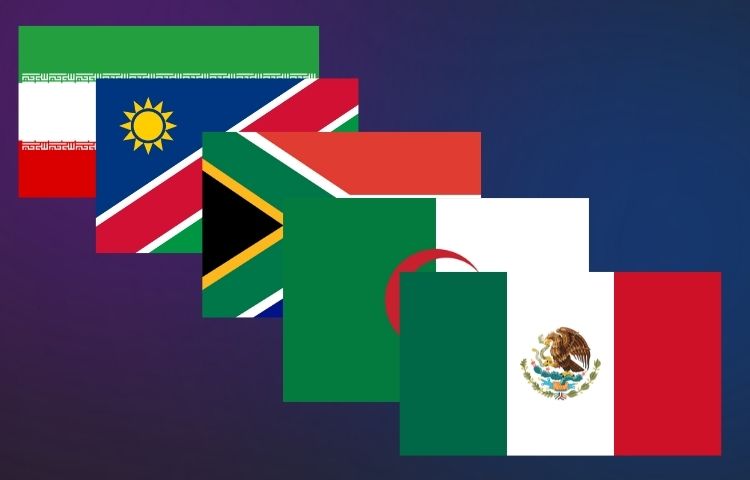Flags are important symbols for each country because they represent its people, history, goals, and beliefs. A flag also signifies a government and the facts and ideals it upholds.
Flags are available in a range of colours and styles to aid in the identification of nations. A national flag flying outside of its native country indicates that the government is involved in the ownership of a project or activity.
The colours and designs on the flag have a deeper meaning. Various countries use red, green, and white flags. At least one underlying meaning exists for each colour.
Meaning Of Red, Green & White Colours on Flag
The colour red may be found in almost every colonial country. It symbolises the bloodshed that took place throughout the revolution. In terms of strength, force, energy, and battle, it also depicts the struggle for independence from colonial masters.
The white hue of the flags indicates the following:
- Purity and Peace.
- Religion.
- Honesty.
- Harmony.
- Mineral riches and silver wealth are two different types of wealth.
- Freedom and Snow.
- Clarity.
- Dignity.
- Panarabismo, or Arab unification, is a term used to describe the process of bringing all Arabs together (along with the colours black, red and green).
- An inheritance or Pan Slavism in Slavic culture (along with the red and blue colour).
The flags’ green colour represents the following:
- Landscapes, greenery, and fertility are all things that come to mind while thinking of landscapes.
- Islam as a religion.
- Hope.
- Agriculture is a very important part of the economy.
- Natural resources are limited.
- Peace.
- Prosperity.
- The African Union or Pan-Africanism (along with the red and yellow colour).
- Pan-Arabism, sometimes known as Arab unity, is a political movement in the Arab world (along with the colours black, white and red).
Lets jump to our list of most influential countries with Red, Green and White Colours Flags:
Mexico

Mexico’s flag is a perpendicular tricolour of green, white, and red with the national coat of arms charged in the white band’s centre. The coat of arms of Mexico was altered in 1968, however the general design has been in use since 1821, when the First National Flag was established. Mexico’s national army is represented by the colours red, white, and green.
Symbolic Meaning Of The Flag
The Mexican flag is rich with national symbolism. The Independence Movement is symbolised by the green band. The purity of the Catholic faith is symbolised by the white band. The red ribbon represents the Spaniards who banded together in the fight for independence, as well as the blood of the state heroes.
Kuwait

Kuwait’s flag was formally hoisted on November 24, 1961, after it was adopted on September 7, 1961. The Kuwait Flag was red and white in 1961, similar to the flags of other Persian Gulf governments at the time, with the arena red and words or custodies printed in white.
Symbolic Meaning Of The Flag
Kuwait’s flag was officially authorised in 1961. It’s composed of three bands in traditional pan-Arab hues of green, white, and black. A black trapezoid is located on the flag’s left side. The official explanation of the colours is as follows: white represents our actions, green represents our pastures, black represents our hardships, and red represents a future blemished by the blood of our enemies. Green represents fertility, white calm, scarlet chivalry, and black battleground or sand kicked up by Kuwaiti provisos while aggressive for freedom, according to another interpretation based on the standard Arabic rhyme. Kuwait was once a part of the Ottoman Empire, but it gained independence and continues to fly the same flag.
Namibia

Namibia’s flag was first adopted on February 2, 1990. The National Symbols Sub-Committee held a competition and received numerous ideas for the national flag. Three designs were chosen for the Namibia Flag from hundreds of submissions. Finally, the constituent Assembly chose the most appropriate design for the nation flag from three options.
Symbolic Meaning Of The Flag
Namibia’s flag is made up of two triangles that are separated by a diagonal stripe in the middle. The colour of the top triangle is blue, whereas the colour of the bottom triangle is green. The red diagonal band that runs between them is encircled by white. It extends from the bottom hoist-side corner to the flag’s opposing corner. A gold sun with 12 triangular rays extending from all directions adorns the top triangle.
The flag’s colours and symbols all have their own distinct meanings. The colour blue represents the sky and the ocean, both of which are vital to the country’s well-being. The republic’s people, their bravery, and their determination to create equal opportunity for all in the future are symbolised by the colour red. The colour white in the flag denotes peace and unity. The green colour represents the country’s agricultural abundance and flora.
Palestine

From top to bottom, the Palestinian flag is a tricolour with three horizontal bands that are black, white, and green. This flag is made up of Pan-Arab colours that signify the State of Palestine and Palestinian people. The Palestinian Liberation Organization first endorsed it on May 28, 1964.
Symbolic Meaning Of The Flag
The first Islamic group to emerge following the assassination of Caliph Uthman III and the Prophet Mohammad is represented by a black colour line on the Palestinian flag (570-632). “There is only one God (Allah), and Mohammad is God’s Prophet.” As a reminder of the Prophet’s first battle, the white stripe is a significant hue. Abdullah Al-Mahdi formed the stripe green in Morocco, and it went on to control all of North Africa.
Peru

The Peruvian flag was recognised by the government in 1824, although it was changed in 1950. Peru’s flag is a vertical triband with red outside stripes and a single white centre band, according to Article 49 of the Constitution of Peru. It can be defiled with various insignia and given different titles depending on its intended use. On the 7th of June, Peru celebrates Flag Day, the anniversary of the Battle of Arica.
Symbolic Meaning Of The Flag
The Peruvian flag’s colours depict and symbolise individuals and their effect on Peru. Jose de San Martin, The Liberator, picked the colours. The coat of arms depicts important emblems of the state in a prosperous environment.
Portugal

On June 30, 1911, the Portuguese flag was legally adopted. The colour green represents King Henry the Navigator, a famous Portuguese sailor. The centred shield with the Portuguese flag is typical of maritime exploration and the expansion of Portugal’s authority during King Afonso Henriques’ reign. The colour red harkens back to the early 1800s’ interior revolution.
Symbolic Meaning Of The Flag
The green is said to represent the Portuguese people’s hope, while the crimson is said to represent the blood of those who died while serving the country.
South Africa

South Africa’s flag was developed and designed in March 1994, and it was accepted on April 27, 1994, at the opening of the country’s 1994 general election, to replace the flag that had been in use since 1928. The new South African flag, designed by the country’s then-State Herald Frederick Brownell, was chosen to symbolise the country’s new democracy following the end of apartheid.
Symbolic Meaning Of The Flag
The South African flag was the world’s only state flag with six colours in its basic design and no seal or brocade at the time of its approval. The design and colours are a mash-up of key components from the country’s former flags. The colours themselves are meaningless.
Afghanistan

Since the beginning of the twentieth century, the Afghanistan Flag has represented 22 distinct Afghan flags. The Islamic Republic of Afghanistan adopted the present flag on January 4, 2004, according to Wikipedia. The vertical stripes signify the past, as well as the Islamic faith and bloodshed during the war for independence. Although Afghanistan’s national flag has seen numerous revisions over the years, the mosque with its Mihrab offering prayers facing Mecca has remained unchanged. The flag has undergone various revisions over the last 28 years, but the stripes still reflect Islam’s creed, as well as the fight for truth and dignity. It is one of the oldest flags, having undergone many alterations over the last two centuries.
Symbolic Meaning Of The Flag
A tricolour and three vertical bars of black, red, and green make up the Afghani Flag. The dark tone represents Afghanistan’s harrowing history as a British colony stretching back to the 19th century. Until 1919, the crimson hue represented bloodshed and independence fights (Anglo-Afghan Treaty). Finally, the colour green represents wealth and hope, which is vital to the survival of the country. Surprisingly, the Afghan flag is one of just five national flags in the world to include a building in its design.
Algeria

When it comes to describing how people feel when they see the Algerian flag, the colours and symbols are associated with Islam and Arab dynasties. The green-and-white in the flag was dropped in 1920 by Khaled, Abdelkader’s grandson and Algerian nationalist leader Ahmed Messali Hadj. The current Algerian flag was designed by the National Liberation Army and the National Liberation Front in the 1950s. The country gained independence on July 3, 1962.
Symbolic Meaning Of The Flag
The features included in the Algerian flag are described precisely, according to Algeria-un.org, quoted in 1999, with the green being defined as a mixture of equal yellow and blue. The contrasts diagram is made up of rood, a wavelength, and 600 on the normal spectrum. The red of the flag is pure and the principal non-decomposable colour.
Iran

Iran’s flag is a tricolour consisting of equal horizontal bands of green, white, and red with a national insignia (“Allah”). The Iranian flag contains a red symbol in the centre of the white stripe.
Symbolic Meaning Of The Flag
The flag’s green colour represents Iranian culture; it represents growth, happiness, unity, landscape, vitality, and Iranian languages. Because white denotes blankness and the ability to hold anything on it, it represents freedom. The colour red is associated with martyrdom. It represents bravery, fire, life, love, warmth, and refinement. The Iranian flag symbolised the Iranian people’s unity and victory.










